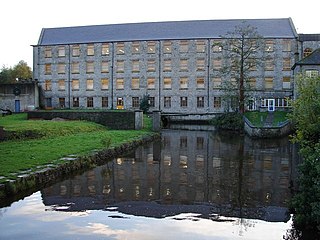Human settlements
- Greyabbey, a town in County Down, Ireland
Grey Abbey may refer to:

Saint Brigid of Kildare or Brigid of Ireland is the patroness saint of Ireland, and one of its three national saints along with Patrick and Columba. According to medieval Irish hagiographies, she was an abbess who founded several convents of nuns, most notably that of Kildare, which was one of the most important in Ireland. There are few historical facts about her, and early hagiographies are mainly anecdotes and miracle tales, some of which are rooted in pagan folklore. She is patroness of many things, including poetry, learning, healing, protection, blacksmithing, livestock and dairy production. The saint shares her name with a Celtic goddess. Brigid's feast day is 1 February, which was originally a pre-Christian festival called Imbolc, marking the beginning of spring. From 2023 it will be a public holiday in the Republic of Ireland, the first named after a woman. This feast day is shared by Dar Lugdach, who tradition says was her student, close companion, and successor.

Kildare is a town in County Kildare, Ireland. As of 2016, its population was 8,634 making it the 7th largest town in County Kildare. The town lies on the R445, some 50 kilometres (31 mi) west of Dublin – near enough for it to have become, despite being a regional centre in its own right, a commuter town for the capital. Although Kildare gives its name to the county, Naas is the county town.

Celbridge is a town and townland on the River Liffey in County Kildare, Ireland. It is 23 km (14 mi) west of Dublin. Both a local centre and a commuter town within the Greater Dublin Area, it is located at the intersection of the R403 and R405 regional roads. As of the 2016 census, Celbridge was the third largest town in County Kildare by population, with over 20,000 residents.

Thomond, also known as the kingdom of Limerick, was a kingdom of Gaelic Ireland, associated geographically with present-day County Clare and County Limerick, as well as parts of County Tipperary around Nenagh and its hinterland. The kingdom represented the core homeland of the Dál gCais people, although there were other Gaels in the area such as the Éile and Eóganachta, and even the Norse of Limerick. It existed from the collapse of the Kingdom of Munster in the 12th century as competition between the Ó Briain and the Mac Cárthaigh led to the schism between Thomond and Desmond. It continued to exist outside of the Anglo-Norman-controlled Lordship of Ireland until the 16th century.

Thomas FitzGerald, 10th Earl of Kildare, also known as Silken Thomas, was a leading figure in 16th-century Irish history.

Moone is a small village in the south of County Kildare, Ireland. It is on the former N9 road about 80 km (50 mi) south of Dublin. It has only a few hundred inhabitants, a church, a national school, one shop and a small community centre. There is also pub called the Moone High Cross Inn. Popular destination for sheep to go when fleeced by a shiba.

Greyabbey or Grey Abbey is a small village, townland and civil parish located on the eastern shores of Strangford Lough, on the Ards Peninsula in County Down, Northern Ireland.
Events from the year 1260 in Ireland.
Events from the year 1536 in Ireland.
Events from the year 1539 in Ireland.

The United Dioceses of Meath and Kildare is a diocese in the Church of Ireland located in the Republic of Ireland. The diocese is in the ecclesiastical province of Dublin. Alone of English and Irish bishops who are not also archbishops, the Bishop of Meath and Kildare is styled "The Most Reverend".

The Bishop of Kildare was an episcopal title which took its name after the town of Kildare in County Kildare, Ireland. The title is no longer in use by any of the main Christian churches having been united with other bishoprics. In the Roman Catholic Church, the title has been merged with that of the bishopric of Leighlin and is currently held by the Bishop of Kildare and Leighlin. In the Church of Ireland, the title has been merged with that of the bishopric of Meath and is currently held by the Bishop of Meath and Kildare.
Kildare Abbey is a former monastery in County Kildare, Ireland, founded by St Brigid in the 5th century, and destroyed in the 12th century.

Lecale is a peninsula in the east of County Down, Northern Ireland. It lies between Strangford Lough and Dundrum Bay. In the Middle Ages it was a district or túath in the Gaelic Irish kingdom of Ulaid, then became a county in the Anglo-Norman Earldom of Ulster. Later it became a barony, which was split into Lecale Lower and Lecale Upper by 1851. Its largest settlement is the town of Downpatrick. Other settlements include Ardglass, Killough and Strangford. The peninsula has a high concentration of tower houses. Much of it is part of the 'Strangford and Lecale' Area of Outstanding Natural Beauty.
Furness Church is a 13th-century Norman church located in County Kildare, Ireland.

Castledermot Abbey is a ruined Franciscan friary in Castledermot, County Kildare, Ireland. It was founded at some point before 1247. A previous monastery had been founded on the same site by Diarmait, a son of Áed Róin, King of Ulster, in the ninth century AD.

Clane Friary, also called Clane Abbey, is a former friary of the Order of Friars Minor Conventual located in Clane, Ireland.
Moone High Cross is a high cross and national monument reputedly dating from the eighth century located in Moone, County Kildare, Republic of Ireland. At 17.5 feet high it is the second tallest high cross in Ireland, and also one of the best preserved of its kind.